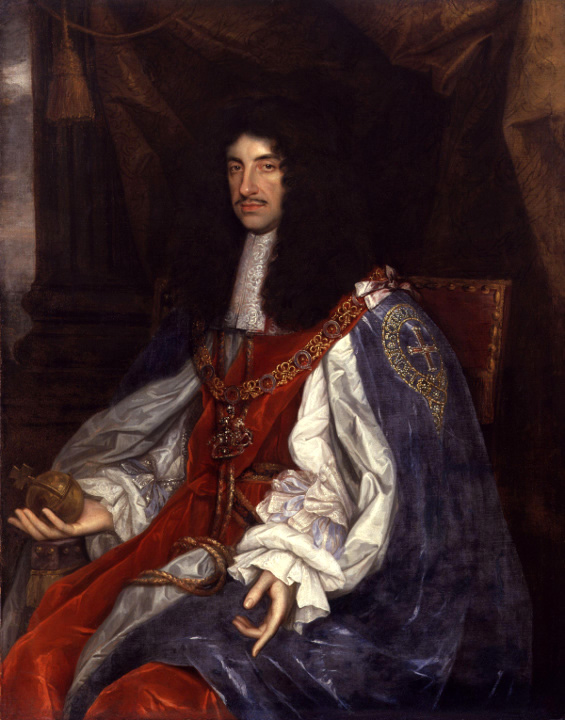Charles II was born on May 29, 1630. His upbringing was tumultuous, given his father, King Charles I’s, power struggles with Parliament. As early as his teenage years, Charles II accompanied his father in military operations and was even put in command of some regiments.
Charles I had previously sent his wife, Henrietta Maria, to France for safety, where she had received a warm welcome. She was the daughter of Henry IV, king of France and Navarre, and Marie de Médicis, of the ruling family of the city of Florence in Italy.
Eventually, Charles I was imprisoned, tried for treason, and executed. Charles II then became the king of both England and Scotland. In June 1650, Charles arrived in Scotland, promising to recognize that the Presbyterian Church was the dominant sect in Scotland.
  |
The Scottish Covenanting Army under David Leslie was defeated by Oliver Cromwell, now virtually the ruler of England, at Dunbar in September 1650. A year later, determined to press his right to the throne, Charles and Leslie invaded England. Cromwell would ever after call his victory at Worcester his “crowning mercy.” For some 45 days, Charles remained in hiding before he could make his escape to France.
Cromwell ruled in England until his death, when his son, Richard, assumed the role. However, he was unable to muster public support and resigned in May 1659. Charles was called back to England, and he returned on his 30th birthday—May 29, 1660.
Charles’s reign was seen by most as a welcome return to normality after the harsh Protectorate of Cromwell, who had eventually divided England up to be ruled by major-generals answerable only to him. Even the theaters had been closed because of strict Puritan morality—not to be opened again until Charles had become king. Determined to be a very different king than his father had been, Charles was careful to avoid the frictions over church and state that had cost his father so much.
At home, he attempted to find some common ground between the Scots Covenanters and the Church of England. Although his efforts eventually ended in failure, he permitted on the whole both churches to follow the dictates of their own consciences. While his efforts at ecclesiastical reform did not meet his expectations, Charles’s relations with Parliament—his father’s sworn enemy—were much more fruitful.
In 1665, growing commercial rivalry at sea led Parliament to encourage Charles to declare war on the Netherlands. While the British Navy was large, the Dutch had more gifted commanders. To complicate matters further, Charles was distracted in the middle of the war by the Great Fire of London and the great plague of London and was unable to wage the war fully against the Dutch.
 |
| The arrival of King Charles II of England in Rotterdam, may 24 1660 |
A peace was reached in 1667, leaving conditions almost unchanged from before the war began. With an eye toward the future, Charles continued the program of modernizing the British fleet.
Revenge on the Dutch
In 1670, Charles’s determination to have revenge on the Dutch led to the Treaty of Dover with Louis XIV king of France, who would attack the Dutch in 1672. Charles, whose finances were subject to the approval of Parliament, agreed by the secret treaty to become a Catholic (he already had Catholic sympathies from his mother) and to support Louis in his coming war with the Dutch.
Knowing nothing of his secret agreements, Parliament urged Charles to support the Dutch against the French. Charles, without actively going to war against his ally Louis, made peace with the Dutch at Westminster in 1674.
   |
With military matters settled, the question of the succession to the throne became a dominant concern of Charles. Lacking any legitimate heirs, the next in line to the throne was his brother James, the duke of York. James was a proven military leader, but unlike his brother, he was openly Roman Catholic.
Consequently, the Protestants in Parliament moved to bar his succession to the throne. Two test acts, which involved allegiance to the Church of England, had already been passed to bar Roman Catholics from sitting in either house of Parliament, the House of Commons or the House of Lords.
A “Popish Plot,” inflamed by an Anglican agitator named Titus Oates inflamed sentiments against the Catholics in 1678 and was one of the reasons that Charles dissolved Parliament in 1679, despite its having sat without interruption since he had come to the throne in 1660.
Between 1679 and 1681, the struggle continued between the Parliament and the king. At about this time, the Rye House Plot was discovered, which included an apparent attempt to assassinate the king. Public sentiment veered toward the king again, and the last four years of Charles’s reign passed mostly uneventfully. A much-needed alliance with Parliament remained largely intact.
When Charles II died on February 6, 1685, the people remembered him for his bright court life, his colorful mistresses, and the style that graced his reign. For the British, Charles II would always be remembered as the “Merry Monarch.”
